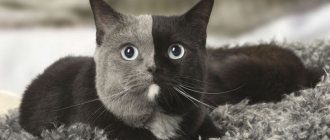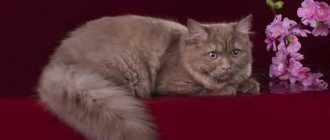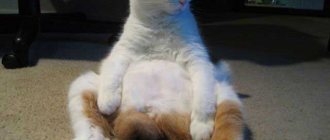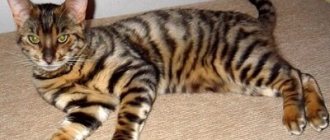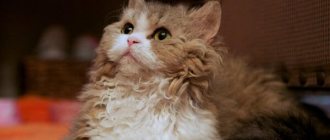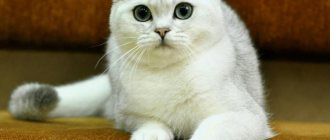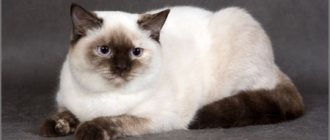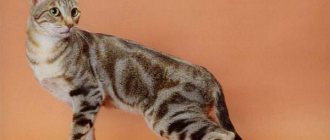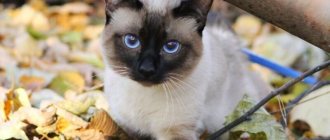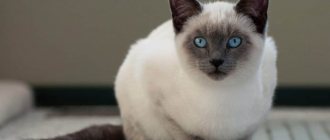The British Shorthair is one of the most popular cat breeds today. It occupies a leading place in popularity in its native country, and in Russia there is a representative of this genus in every second family.
In fact, this is a very old species of cat, the ancestors of the British appeared back in the 1st century AD. Let's take a closer look at this beautiful and ancient breed.
Here is a photo of a classic British Shorthair cat with blue color and bright orange eyes.
Origin of the British Shorthair cat breed
Most modern felinologists have still not come to a final conclusion as to when the first representatives of the British Shorthair appeared. Many even suggest that the first kittens of this breed were recorded back in the days of Ancient Rome.
If we talk about the date of registration of the breed, then the first fluffies that fit the description of the British Shorthair appeared in Great Britain in the middle of the 19th century. Thanks to their activity and developed hunting instinct (these purrs love to chase rats and mice), they have gained popularity among many peasants who want to protect their crops from rodents.
With the spread of fluffies throughout the British Isle, it became necessary to record the characteristics of the breed. This allowed the British to take part in the cat exhibition that took place in London at the end of the 19th century. Plush fluffy cats have since become popular not only among peasants, but also among aristocrats. They appeared on the canvases of artists and became heroes of stories (for example, the famous Cheshire cat from the fairy tale “Alice Through the Looking Glass” was a British shorthair).
Due to the fact that this breed was bred naturally and was not crossed with other cats, it managed to retain all its original features and characteristics even after several centuries.
Initially, this breed of cat was called British Blue (due to the characteristic color of the animal). However, over time, many other colors of cat fur appeared. Today, there are more than 100 color options for fluffies, which was the reason for changing the name of the breed to British Shorthair.
British longhair cat
British Longhair cats are a type of British cat and in modern times are considered an independent breed. When breeding a British Shorthair cat, kittens with long hair, carrying the gene for long hair, were eliminated, as they were a “reject” of the breed.
Now animals with long hair are considered a separate species and are very popular. British longhair cats carry the blood of shorthair cats (must have their type and bone structure) and Persian cats (they inherit long hair). But it doesn’t always work out this way, and often the animals did not meet the established standards, so there are still no clearly established descriptions of the long-haired “British”.
British longhair cat
History of the origin of the breed
British longhair cats appeared during the development of new coat colors by crossing British and Persian breeds. The gene responsible for long hair is recessive, so the first few generations were short-haired, but subsequent breedings produced kittens with long hair.
Such kittens were considered “defective” and were discarded, but some experts decided to take a different path and began to actively study British cats with long hair. Thus, while breeding long-haired British cats, breeders tried to achieve the ideal look. However, hybrid individuals were born with severe skull defects and soft fluffy hair, so the breeders decided to breed only the most successful hybrids.
Exterior
In general, British Longhairs are no different in appearance from British Shorthairs, except for the length of their coat.
Table 2. Exterior of the British Longhair cat
| Characteristics | Description |
| Head | Large, massive, with full cheeks. Nose straight, short |
| Eyes | Match the color |
| Ears | Small, rounded |
| Body | Massive, with developed muscles and short limbs |
| Tail | Fluffy, with rich undercoat |
| Wool | Medium length, preferably a frill and pants |
External features of the breed
As I already said, the appearance of the British Blue cat has changed little since the 19th century. Let's take a closer look at the main features of the appearance:
| Criterion | Description |
| Head | Has a round shape |
| Nose | Straight, smoothly blends into the forehead. |
| Ears | Small in size, slightly rounded in shape, planted at a wide distance from each other. |
| Eyes | Large, round in shape. Like the ears, they are set wide. They are distinguished by their large size and, as a rule, a deep amber or yellow hue. Some colors (for example, point) have gray-blue eyes. |
| Chest and shoulders | Wide, large. |
| Paws | Dense, short, quite strong. |
| Tail | It has a rounded shape and is long. It has a wide base that tapers towards the tip. |
| Wool | Plush with a shiny shimmer, quite thick and, as the name suggests, short. The undercoat is pleasant to the touch and has a dense texture. |
| Weight | Adults weigh from 8 to 12 kilograms |
| Overall growth | 30-35 cm. |
Description of the breed
This variety is purebred, it differs from the Scottish one, with which it is often confused, precisely because the second one appeared as a result of genetic experiments.
The heroes of this material are similar to the Cheshire Cat from Alice in Wonderland, because the pictures were written from him! Here are the external characteristics of these beauties:
- Round head with a round muzzle, full cheeks, wide skull. The neck is almost invisible. The nose is straight and wide, short. Transition to the forehead with a deepening. The ears are set low, and they themselves are small and rounded at the tips, with fur clearly visible on them. The eyes are huge and wide open, widely set, gold or blue in color. Chinchillas also have lavender and emerald shades. Dull color is a minus, the same can be said about the halo around the pupil.
- The body of these creatures is large-boned and can be medium or large. The muscles are clearly visible, the torso is wide, the back is massive. The legs are short and strong, the tail is the same, gradually narrowing. Girls are smaller than boys, usually weighing four to six kilograms, while the latter weigh five to eight.
- The fur can be short or long. In the second case, it is of medium length, straight, with a clear undercoat and dry guard hairs. The pants and collar are visible. The tail is very shaggy. Short-haired representatives have dense, delicate, uniform fur, very pleasant to the touch, like plush.
- The color can be uniform, smoky or shaded; black, white, blue, cream, lilac and red individuals are most often found among monochromatic ones. Bicolors come in bluish-silver, tabby, ticked and marbled. Chocolate pussycats often have fur that does not meet density standards.
Disadvantages are considered to be too noticeable underears, a hump on the nose, a flat forehead, a nose that is too long, and a fox-like face.
Personality of the British Shorthair
Moving away from appearance, let's talk about the character of British cats. Fluffies have a quiet and calm disposition, making them ideal for people who like to spend time in peace and quiet. Like true Britons, these animals have aristocratic habits - they do not like to throw things off, damage furniture or wallpaper, and would rather give up active games in favor of a more relaxing pastime.
Of course, during adolescence, furries can get a little naughty. However, an adult British Shorthair cat shows restraint in character and is independent. She loves her owners, but prefers to spend most of her time alone (for example, watching what is happening outside the window).
At the same time, purrs are very inquisitive and active, they love to try something new. This breed of cat is perfect for people who, due to circumstances, are forced to spend a lot of time traveling or at work. Pets do not get bored when they are alone in an apartment and can easily occupy themselves in the absence of a person.
At the same time, the British are very loving. They do not have a favorite among one person and are equally attached to all family members. From time to time, a cat may ask for attention. Spend time with the animal talking and playing. The main thing is not to violate the furry’s personal space if he wants to be alone.
This breed of pet quickly finds common interests with other animals.
Interesting : The vast majority of British Shorthair cats do not like it when you carry them in your arms for a very long time. So you shouldn’t regularly move your animal from room to room. The cat feels much better with all four paws on the ground (floor).
Reviews from British cat owners
“My Churchill behaves like a true aristocrat; one can envy his restraint. He tolerates nail trimming and brushing, never meows over trifles, but purrs and purrs so that you can hear him from everywhere. We joke that this is the ringtone of our house. Although he is an independent man, he always meets and accompanies him to work. When he wants to be pampered, he has to put everything aside and scratch and stroke. Smart as a person. Always looks straight into the eyes. Adored beyond belief!”
“Sir Tyson is the most beloved member of the family. But he can’t be picked up, he can’t lie on his lap, he can’t sleep on the floor - only on his personal chair. He eats the same brand of food and has never stolen from the table. Talking to us. When he is being petted before bed, we pay attention to him while he is in the mood.”
“When you return from work, the cat appears slowly, almost piecemeal, like the Cheshire cat. He sits down and looks - they say, where they were hanging around and how long to stay with us. Slowly washes off. He may freeze with his paw raised - he is thinking about something. He never asks for food. At most he can sit by the bowl, doesn’t look at you, just a living reproach. If you catch him eating something from the table, he doesn’t run away, doesn’t scream - sorry, it’s not me, the devil has confused him. Oh no! He simply looks reproachfully at where the equipment is and why he is forced to eat in such poor conditions. Mars sheds constantly, tolerates a dacha, but is not enthusiastic about fresh air.”
“They allow themselves to be loved - these words say it all. And you will be happy that you were allowed to live with these celestials."
“Zero attention to pussy-kiss-kiss, he won’t even turn an ear. It’s worth calling by name - immediately interrogative Mr-r-r-r, no matter where she is at that moment.”
“I had a British guy. I still remember with irritation how contempt for bipeds was imbued with his every glance. The self-esteem is simply exorbitant. I described the entire apartment, the stench could not be removed by any means.”
Maintenance and care
The British Shorthair cat will fit perfectly both in a small apartment and in a large private house. The main thing is to provide the animal with a sleeping place, which can be a blanket, your clothes or a special bed for kittens. In addition, you will need to buy:
- tray;
- tray filler;
- scratching post;
- toys;
- bowls for food and water;
- furminator.
The plush coat needs to be brushed 1-2 times a week. To do this, use a special brush with natural bristles.
About 2 times a month, clean the animal’s ears and bathe the cat.
If you do not want to breed British kittens, sterilize the animal in a timely manner. This will help avoid many diseases in the future.
Black smoky colorEdit
Scottish cats and black smoke cats seem not as black as their solid counterparts due to the light undercoat: the hair is not dark along the entire length, but is colored plus or minus half. The color does not seem uniform, but as if it has inclusions or tints.
READ Ball under the skin of a cat
The Scottish Fold or straight-eared smoky kitten has a color that can shimmer when moving, changing slightly depending on the lighting. Because of this, many inexperienced owners cannot determine what color their animal is - either solid (if the smoke is very uniform), or tabby (if the color is uneven, looks like a patterned one). In fact, these are Scottish smoke-colored kittens.
With age, the smoky color, similar to a tabby, can become full-fledged smoke, or it can remain so patterned. In the second case, we are dealing with an insufficiently good smoky color. Poorly colored smoky shorthaired cats are sometimes confused with tabbies because... it seems like they are striped.
An adult smoky cat has a residual pattern
You can distinguish black smoke, no matter how good or bad it is, from others by looking at the mirror of your nose. The smoky cat has a black nose without a line, unlike the tabby cat. And in order to distinguish smoke from black solid (solid color), you need to move apart the undercoat and look at the presence of two different colors in the smoke or at solid color in solid.
As an adult, around the age of two, the Scottish Smoky cat has a fully formed color. The lighter the lower part of the hair, the more valuable the cat is. It is desirable that the contrast of colors be uniform throughout the body. Long-haired cats, that is, Highland Straights and Highland Folds, look more advantageous with this coloring - the shimmer is more noticeable on them.
Persian smoke cat
In the international classification, the smoky color is designated by the letter s (from the English “smoke”, which means “smoke”).
There are usually few smoky cats at shows, because... The quality of their color is influenced not only by genetics, but also by many circumstances: they are rarely in ideal shape. At the same time, judges are very picky about the shortcomings of this color, so it is difficult to get a title.
To get black smoke, a cat must have not only the gene for black coat color B and pigment density D, but also the smoky color inhibitor gene, which blocks the synthesis of pigment in the cells of the hair follicles. As a result of its action, only the upper part of the guard hair is painted, and the root part remains devoid of pigment. As soon as the hair stops growing, i.e. reaches its maximum, the inhibitor gene I (from the word “inibitor”) stops acting on this hair.
However, the inhibitor gene in combination with the gene for density and black pigment is not enough for the animal to be smoky. Such individuals also have non-agouti (aa) genes, that is, genes for non-patterned (non-tabby) colors. The combination of aaII (or aaIi) genes produces haze.
Owners of such fur have golden or copper-colored eyes with a black border. Skin color in hairless areas is black or dark brown.
Nutritional features of British shorthair cats
When it comes to food, British cats are very picky. Of course, it is advisable to give animals special food designed specifically for this breed and avoid cheap food.
Many people believe that table foods (foods that family members eat) are ideal for their four-legged friends. However, this is not quite true. Modern feeds have a balanced diet that contains all the vitamins and microelements necessary for the normal growth and development of the animal. So, when choosing what to feed your British kitten, give preference to premium, super-premium, and holistic food. You can read more about cat food here.
The British Shorthair cat responds well to both dry types of food and wet or pate.
Please note that the British are not very active. With age, they become completely lazy. So make sure your pet doesn't gain weight. This breed tends to have problems with obesity (this is especially true for sterilized cats and female cats).
On average, regarding feeding, veterinarians recommend calculating the daily portion as follows: 65-70 kilocalories per 1 kilogram of animal weight. You should strictly avoid foods such as: smoked meats, cow's milk, corn, onions, garlic.
Health
Since Britons are naturally bred, excellent health comes with them from birth. The only thing to be wary of are breed-specific diseases: heart disease, parasites, diarrhea, obesity, hair loss and nail fungus.
These troubles will bypass you if you monitor your pet’s health, take it for checkups and vaccinate it on time.
On average, the British live 10-15 years, some live up to 20, it all depends solely on the owners. A calm environment and a balanced diet will allow your pet to live a long and happy life.
Health and illness
Since shorthair cats were naturally bred, they tend to be in fairly good health. Pets rarely get sick and do not have serious genetic abnormalities. With proper care, British cats can live up to 20 years.
The first rule that anyone who wants to adopt a British dog must adhere to is timely vaccination. Timely vaccinations will protect your cat from rabies calcivirus and many other serious infectious diseases. Also, prevention against worms is important. All these questions should be addressed to an experienced veterinarian. It is he who will determine the vaccination schedule for the animal.
The only health problem that is common to all representatives of this breed is obesity. Do not overfeed your pets with too high-fat, high-calorie foods. Otherwise, with age, problems with the cardiovascular system and gastrointestinal tract may arise. Be sure to regularly take your cat for examination to the veterinarian for prevention and timely treatment of diseases.
Many potential furry owners are interested in how long British Shorthairs live. The life expectancy of this breed is quite high, ranging from 13 to 16 years.
Ability to live together with other animals
If several cats live in an apartment, then the British cat will take its rightful place among them. As a rule, he lives in peace and harmony with other cats.
With dogs it’s a different matter, especially if they are playful and like to pester others. A British cat will categorically not like this attitude, an encroachment on personal space.
If a British cat kitten appears in the house, then he, of course, can play and run around with the dog. They can be friends and maintain a normal relationship. On the contrary, an adult British cat will most likely not like the appearance of a fidgety puppy in the house.
The British like aquarium fish, but only as an object of observation. Representatives of this breed have not been seen fishing (although every rule has its exceptions).
Hamsters, rats, guinea pigs and other small animals make Britons remember their hunting instincts, so these types of animals most likely will not be able to live together.
Photos of British Shorthair cats
I have already said that there are several dozen color options for British Shorthair cats. Each of them is interesting and undoubtedly deserves your attention. Highlight:
- Solid color. In this case, all the fur of the fluffy has the same shade. Solid colors include: black, brown, chocolate, lilac, blue, red, milk, white, gray. The rarest ones are those with black or red fur.
- Turtle (tortie). This is a beautiful combination of shades that is often found in British Shorthair kittens. As a rule, it appears in a combination on the body of red (red) and black, as well as blue (gray) and milky.
- Color point. Externally, this color strongly resembles Siamese cats. Among British shorthair cats, color point is found in such variations as: cream, red, lilac, chocolate, blue.
- Tabby. This color is reminiscent of brindle, and also has much in common with the British harlequin. Another main feature of this type of coloring is the characteristic darker M-shaped pattern located on the animal’s forehead, as well as several rings on the pet’s tail and paws. Among British shorthair kittens, the golden and silver tabby colors stand out.
- Chinchilla. In another way, this color is also called smoky. The undercoat of such pets, as a rule, has a light shade. While the tips of the fur are colored dark. The presence of light hair on the sides of the animal is also characteristic.
- Bicolor. This color implies inclusions in the main shade of white. For example, you can often find bicolor as a combination of tortoiseshell and white.
What breeds were involved in the creation of British cats
British cats are considered by some to be an aboriginal breed - one that formed on its own, without active human intervention. In many ways this is true. Cats were brought to the islands of Great Britain by Roman legionnaires many years ago. On an island isolated from the mainland, the cat population developed “in itself”, without the infusion of fresh blood, but with strict natural selection. After all, cats did not live in houses, but on farms, fields, grain barns and factories. As a result, large cats with heavy bones and dense, thick short hair roamed the streets of England.
British cream color
At the end of the 19th century, targeted selection of British cats began, and for some time the breed was called the “British Blue”. At first, blue was the only acceptable color, then it was the most common, but now the variety of colors of the British is amazing.
"Classic" blue color of British cats
The breed's numbers declined twice in the 20th century - after the First and Second World Wars. In order not to lose the British, they were crossed with ordinary outbred shorthair cats. And in order to return the desired rounded appearance of the head, they began to involve in the breeding of Persians.
It was not possible to obtain stable offspring, and the British began to be mated with Russian blue cats, as well as Chartreux cats. Then they returned to the infusion of Persian blood, weeding out kittens that were too snub-nosed or had long hair. It was the Persians who “gave” British cats more than 200 variations of coat color.
In 1982, the two breeds were finally separated: British and European Shorthair. At the same time, the British breed standard was written.
How much do British Shorthair kittens cost?
If you want to know how much a British cat costs, keep in mind that the price will depend on the purpose for which you are taking the kitten. Regular Britons cost between $100 and $250 depending on color. If you want an animal with a pedigree and plan to breed and sell kittens, you need to take a purr with a noble origin. Its price starts from $300. In this case, in addition to the cat, you receive all the necessary documents confirming its origin.
Exhibition (show class) British Shorthairs are the most expensive category of cats in this breed. They are sold primarily for performance at various exhibitions. The cost of a kitten starts at $500 and can even go up to $2,000. It varies depending on the color. For example, British redheads are considered the most expensive.
There is also a slight difference depending on the sex of the animal. However, it is not that significant. Most often, cats cost a little more (20-50 dollars) than males, since they are taken for breeding.
Many unscrupulous breeders or simply scammers sell a breed called the British Fold. Please note that this breed is not registered by any felinological organization. So, if you want to get a kitten with floppy ears, take a closer look at the Scottish Fold.
Smoky Brits: photo gallery
British kitten black smoke: photo
Classic smoky British kittens come in the following colors:
- black smoke;
- blue smoke;
- purple smoke;
- chocolate smoke;
- cinnamon smoke;
- faun smoke;
- red smoke cameo;
- creamy smoke cameo.
British Black Smoke is a fairly rare, unusual and in demand color. The cat's color is black; when it moves, the white undercoat peeks out all over the animal's body; the cat is very contrasting. The sides of Black Smoke Britons are usually slightly lighter than the back and have a silver tint. British black smoke cats should not have a tabby pattern.
The British cat has black smoke on his nose and black paw pads. A cat's eyes can range from dark copper to bright orange. The cat's collar should be clear silver, and the hairs on the ears should also be silver.
Chocolate smoky Britons are not as rich chestnut in color as they are with the classic chocolate color. The coat tone is slightly paler, silver appears on the sides and belly of British cats, and the animal’s ears are also covered with silver flecks. The undercoat should be as white as possible; any residual pattern on the coat is discarded. The eyes are dark golden or orange. The nose and paw pads are dark chestnut.
British cat black smoke: photo
The color requirements for British Smoky Cinnamon are identical to those for chocolate. The coat color is soft, fairly uniform, with silver on the collar, sides, and ears. Tabby drawing is also not allowed. Smoke is present throughout the animal's fur. The eyes are light amber to dark amber in color, the paw pads and nose are pinkish-brown.
Smokey British fauns are very rare, however, they are found. Silver is present in the classic smoke areas: ears, collar, belly, sides. The color should not contain any residual pattern on the coat. The British smoke faun has orange or copper eyes. The paw pads and nose are pink-sand.
The faun smoky color of British cats generally looks very harmonious, gentle and uniform.
The requirements for blue smoky Britons are very strict. The main color of the coat can be from dark blue to very light, the undercoat is white. Tabby markings are not allowed and are immediately discarded. Light silver is visible on the sides, belly, ears, and collar. When moving, the color casts a very light tone.
The lilac smoky Briton should be of a uniform, even color, with a white undercoat dyed to half a hair. There is a little more silver on the belly and sides of British cats, the collar, as well as the ears, are silver. Tabby markings are not present. The eyes are light to dark orange, the paw pads and nose are dark pink.
Red smoky British are very impressive and contrasting. Silver is preserved on the sides and belly of British cats. The collar is silver and there is also a hint of silver on the ears. Red smoke is the only smoke color in which minimal signs of patterning can be tolerated, although they are highly undesirable.
Cream Smokey Britons should be a soft, even tone with virtually no smoke visible, but when parting the coat we should be able to see the bright silver tone of the undercoat. The back and paws are a richer cream shade, and the sides and belly are slightly lighter. The ears and collar are silver. The residual pattern in cream smoky British cats is rejected. The eyes are copper or golden in color, the nose mirror, as well as the paw pads, are pink.
The gallery contains photos of British dogs of black smoke, chocolate smoke, blue smoke, cream smoke. Here you can see photos of British smoky kittens and adult cats.
READ Kidney failure in cats: symptoms and treatment
Smoky cats have yellow or amber eyes, the nose and paw pads are black, without lining. In the international classification, such eyes are designated by the numbers 62.
Smoky cats are very demanding in care, because... In unkempt animals, the fur becomes discolored, fades, and “rusts.” Care means not only regular brushing and combing of the coat, but also a balanced diet, and also protection from frequent, prolonged exposure to sunlight.
It is recommended to wash black show cats with professional shampoos that enhance the black color. And, oddly enough, it is better to wash black smoky cats with whitening shampoos for white cats. The enzymes contained in such shampoos perfectly whiten the root zone, and make the ends of the hair appear shiny.
In addition to shampoo, when grooming, you can use a balm to volume the coat. Then the hairs will be raised and show off the haze more favorably.
You also need to carefully monitor traces of tears, which dry up and become crusts, and after they are removed, if you clean the area around the eyes irregularly, yellowish spots may remain. It will take a long time to get them out. Therefore, it is better to regularly use cleansing eye lotions for preventative purposes as tear stains appear.
Long-haired smoke-colored Scots need to be brushed frequently to prevent mats from forming. If in cats of a different color the tangles can simply be cut out, then in smoky cats such manipulation will lead to dark guard hairs growing in place of the light undercoat - a dark spot will appear on the body.
Furminators are also not suitable for combing such cats. The fact is that the furminator can damage the undercoat - the result can be as disastrous as in the case of cutting out the mat. Also, such cats should never be trimmed. It is better to bathe thoroughly during molting and comb it either with a regular comb with fairly sparse teeth, or with a special silicone paw.
And, of course, one should not allow heavy or prolonged shedding in smoky animals, so that they do not lose their undercoat, which forms all the beauty, and also so that the coat does not fade. In order for molting to be less intense, a balanced diet and vitamin intake in courses are necessary if the cat is on a natural diet or on non-vitaminized factory feed.
